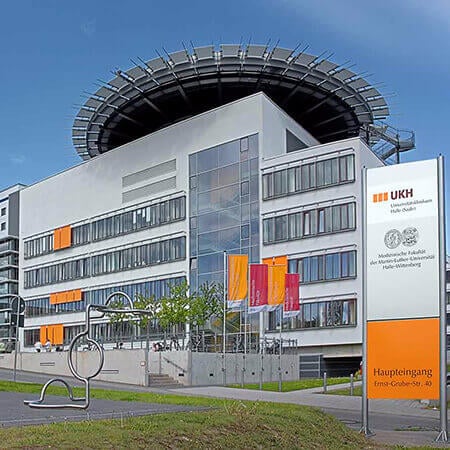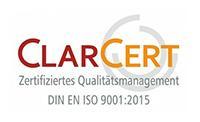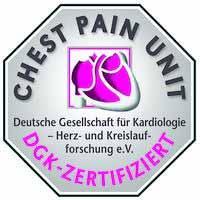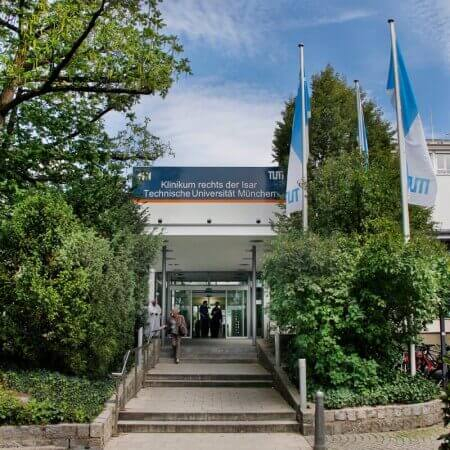Today, coronary insufficiency is among the causes of mortality worldwide. Cardiac disease is most often detected in elderly people. Below you will find out the mechanism of the cardiac condition, how it manifests itself, measures of prevention, and treatment methods available in Germany.
Content
- What is coronary insufficiency?
- Causes of coronary insufficiency
- Forms of coronary insufficiency
- Symptoms of coronary insufficiency
- Characteristics of pain syndrome
- Tactics for treatment in Germany
- Surgical treatment in Germany
- Why is coronary insufficiency dangerous?
- The cost of treatment in German hospitals
- How to start the treatment in Germany?
What is coronary insufficiency?
Cardiac coronary artery disease is a mismatch between coronary vascular functioning capacity and blood supply requirements of the body. Coronary artery disease usually leads to local impairment of the myocardium. In medicine, it is customary to distinguish its two forms: acute and chronic.
Acute coronary insufficiency is characterized by a mismatch of blood flow to the metabolic needs of the myocardium (altered coronary arteries of the heart, angina attacks, severe heart rhythm disturbances, ECG changes may be observed along with the condition). The acute type of cardiac disease often provokes the development of myocardial infarction. Chronic coronary insufficiency is characterized by the prolonged (constant) insufficient blood supply to the myocardium. A prerequisite for the emergence of the pathology is a change in the coronary blood flow.
Coronary insufficiency can also occur in absolute form (blood flow through the coronary vessels is severely limited), and relative form (myocardial oxygen demand increases significantly, but there are no restrictions on coronary blood flow).
Causes of coronary insufficiency
Coronary insufficiency is a cardiac condition in which blood flow through the coronary arteries does not meet the energy requirements of the heart. This results in myocardial ischemia – damage to the cells of the heart due to a lack of oxygen and nutrients. Ischemia is a local process that occurs in the area of the myocardium where its nutrition has been impaired. The process of blood flow deterioration itself is most often explained by the narrowing of the lumen of the blood-bearing vessel.
Coronary insufficiency can occur as a result of processes that lead to a disturbance in the normal flow of blood through the arteries:
- Changes in the tone of the arteries.
- Decrease in the lumen of the arteries.
- Changes in arterial tone.
Vascular wall spasm and decreased arterial tone may be a consequence of increased adrenaline release. For example, under severe stress, described by many as "heart palpitations in the chest", there is a temporary lack of oxygen. This is easily compensated by increased heart rate. As a result, blood flow increases, the flow of oxygen increases significantly, and the mood and well-being of the person improve for some time.
There is nothing wrong with a short-term stressful situation. On the contrary, it can be seen as training to reduce the sensitivity of coronary vessels to spasm (prevention of coronary artery disease). However, if the stress is prolonged, the decompensation phase sets in. This means that the cells of muscle tissue have used up all their energy. The heart begins to beat slower, carbon dioxide levels increase, and arterial tone decreases. The blood flow in the coronary arteries slows down as well. As a result, metabolism in the heart muscle is disturbed. Some of its parts may even die (necrosis). The resulting necrosis is known by the common name "myocardial infarction".
The following factors contribute to the occurrence of pathology:
- Smoking (because of the intoxicating effect on the body of tobacco smoke, the cells of the inner layer of the arteries change, and the risk of increased thrombosis increases).
- Consumption of large amounts of fatty foods (fraught with protein deficiencies, changes in the balance of microelements and vitamins, metabolic disorders).
- Stress (because of the increased adrenaline background there is a prolonged arterial spasm).
- Low physical activity (leads to venous stasis, deterioration of oxygen supply to the tissues, reduced strength of the heart contractions).
Forms of coronary insufficiency
Let us dive deeper into the forms the heart disease is manifested by, which are divided into acute and chronic.
The acute condition implies a sudden deterioration of blood supply to the myocardium, which is most often caused by thrombosis, less often, spasms. Blood supply is not restored after its disruption, which implies the transition from ischemia to necrosis – the death of heart cells. This is myocardial infarction. Manifestations of the acute form in patients often end in death.
The typical manifestation of the chronic variant of coronary insufficiency is angina pectoris. It is most often caused by an atherosclerotic lesion of the coronary arteries of the heart, which causes narrowing of their lumen. Under physical strain, the myocardium requires more blood, while the permeability of the artery is reduced, and ischemia with characteristic symptoms occurs.
When the attacks recur in response to a load of equal severity, we speak about a stable variant of angina pectoris. Its course is relatively favorable and well-controlled. There are other types of its manifestation. These are as follows:
- Unstable angina. A form of angina in which the plaque in the coronary vessel undergoes ulceration, in the lumen gradually grows a clot, from which the attacks are constantly progressing and eventually lead to myocardial infarction.
- Prinzmetal angina (vasospastic angina). The condition occurs as a result of a sudden spasm of the coronary arteries.
All of it is related to absolute coronary insufficiency, where the pathology was caused by various coronary artery diseases. But there is also a relative form, developing due to hypertrophic cardiomyopathy. In this process, the myocardium increases in size due to the increased load. In this case, ischemia of poorly supplied areas also develops.
Symptoms of coronary insufficiency
Symptoms of coronary artery disease may vary from case to case. It is also not uncommon for patients to feel nothing strange about their condition until one day, for example, a myocardial infarction occurs.
Among the most characteristic symptoms patients with coronary heart disease experience are:
- Angina pains: pressing, squeezing, or burning pain behind the sternum lasting up to 10 minutes. Often appears during physical exertion. May start behind the sternum and then spread to the neck, back, shoulders, arms, and jaw.
- Dizziness and fatigue.
- Cold sweats.
- Stomach pain.
- Dyspnea, especially with exertion.
- Sleep disturbances.
The listed symptoms are typical for a chronic (reversible) variant of coronary insufficiency, which is manifested by angina pectoris. In the acute (irreversible) variant, the described symptoms are more pronounced and last much longer, up to several days. Pain in some patients with coronary insufficiency is not relieved by nitroglycerin and may be so severe that it is necessary to resort to narcotic drugs.
Although the main symptom of coronary heart disease is most often severe retrosternal pain (80% of cases), the heart disease also has other manifestations:
- Coughing and shortness of breath.
- Sharp pain in the upper abdomen.
- Symptoms of brain damage.
The asymptomatic form in patients with coronary insufficiency is rare. In this case, the area of lesion in the heart is not so extensive, and changes are recorded instrumentally post factum.
If such symptoms are detected, especially due to unaccustomed physical activity, patients are advised to get medical help as soon as possible. It should also be done if coronary insufficiency has already been diagnosed, but the symptoms are not relieved by nitroglycerin and persist longer than 15 minutes.
Characteristics of pain syndrome
The first and most important step in the diagnosis of coronary heart disease is a detailed description of the pain syndrome. 5 characteristics of pain are usually assessed: its nature, localization, duration, factors provoking and controlling pain. Patients use various definitions to describe the nature of pain associated with coronary insufficiency: "squeezing", "pressing", "bruising", "suffocating". Pain is often described as heaviness or a "stake" behind the sternum. It is not uncommon for patients to describe their sensations as "discomfort," "but not pain."
Patients usually describe the pain localizing behind the sternum, but also spreading to the neck, lower jaw, epigastric region, hands, or fingers. Pain occurring above the lower jaw, below the epigastrium, or localized in a small area in the left half of the chest at the projection point of the apex of the heart is not typical for patients with coronary insufficiency.
However, pain is usually short-lived: not more than 5 minutes in most patients, and sometimes even less than 1 minute. Discomfort or dull pain lasting hours is unlikely to be a symptom of coronary insufficiency. Coronary heart disease is usually triggered by physical or emotional stress and goes away during rest. Pain in the morning hours after getting out of bed and after a meal are classic signs of patients having severe coronary insufficiency. Pain occurring not during, but after physical or psycho-emotional stress is less likely to be experienced by patients with coronary insufficiency.
Tactics for treatment in Germany
The treatment plan for patients with pathology is based on its manifestation, the course of the heart disease, and concomitant cardiac conditions. Considering the individual risks of patients, doctors may prescribe lifestyle changes, drug therapy, or surgical treatment.
Lifestyle changes include weight normalization: losing as little as 3 – 5% of body weight reduces some risk factors for coronary artery disease, activity and regular exercise, proper nutrient-dense diet, ability to manage stress (therapy with a psychologist may be helpful at this point), quitting smoking, and getting enough hours of night sleep (at least 7 – 9 hours for adults) are also recommended.
Drug therapy for coronary insufficiency is aimed at managing the risk factors of heart disease and eliminating its underlying causes. For example, therapy with ACE inhibitors and beta-blockers helps reduce the load on the heart; therapy with calcium channel blockers corrects vascular tone; drugs for blood sugar control reduce the risk of complications from coronary heart disease; metamorphine therapy helps reduce the formation of atherosclerotic clogging of the vessels; drugs from the nitrate group (nitroglycerin) are used to stop and prevent angina attacks.
Surgical treatment in Germany
When therapy in the treatment of coronary insufficiency no longer helps, cardiac surgery is used to restore blood flow in the problematic area of the vessel. There are two main types of surgical treatment: bypass surgery and angioplasty.
With bypass surgery, doctors create additional blood flow to bypass the narrowed area in the vessel. The patient's own veins or arteries are most often used for this. This extra blood flow is called a shunt.
During angioplasty, a balloon is inserted into a narrowed section of the vessel, which dilates the problematic area. During this cardiac surgery, a small incision is made in the aorta, a tube with a balloon at the end is inserted, and is advanced to the site of the narrowed vessel. The effectiveness of angioplasty is up to 95%. Therefore, this type of surgical treatment for patients with coronary artery disease is used more often.
Today, many surgical interventions in medicine are performed as minimally invasive procedures. Angioplasty is one of the effective methods of coronary heart disease treatment, which was originally developed for use in patients with a single coronary vessel lesion in the proximal region. However, over time, the angioplasty method has been improved by the use of a guide during the procedure, intravascular ultrasound, pharmacological support, in particular, the use of drug-eluting stents, which allowed the use of percutaneous transluminal coronary angioplasty in more complex cases.
The percutaneous transluminal coronary angioplasty procedure in German hospitals is performed under local anesthesia. The procedure of percutaneous transluminal coronary angioplasty can now be performed as a stage of angiography. If angiography reveals areas of coronary artery narrowing, when angioplasty and stenting are indicated, angiography can be continued immediately in the form of angioplasty.
Why is coronary insufficiency dangerous?
Coronary insufficiency is often almost asymptomatic, progressing and leading to some complications, the most severe and irreversible of which is coronary death. Among the most common complications are:
- Aortic aneurysm.
- Pericarditis.
- Involuntary vasoconstriction.
- Minor but dangerous anatomical changes in the structure of the heart.
Three degrees of negative consequences of cardiac disease are distinguished in medicine:
- Increased risk of death. It is characterized by angina attacks lasting more than 20 minutes, pulmonary edema, low blood pressure, shortness of breath, darkening of the eyes, and fainting.
- An intermediate degree of lethal risk is defined by angina attacks of less than 20 minutes, nocturnal attacks of chest pain, and the age of the patient over 65 years.
- A low degree of risk is caused by more frequent angina attacks in the last two months, even after non-serious physical activity, absence of new changes on ECG in comparison with the earlier results.
The cost of treatment in German hospitals
Below you will find prices for common treatment methods. We have compiled information on the real cost of treatment in Germany for the widespread treatment options. You can find out prices to evaluate offers from German hospitals and medical companies around the world.
The average prices for coronary insufficiency diagnostics start at 880 EUR.
The cost of treatment in Germany with conservative therapy starts at 2,030 EUR.
The cost of treatment in Germany with percutaneous transluminal coronary angioplasty with stent replacement starts at 3,762 EUR.
The prices for rehabilitation in German hospitals start at 566 EUR.
How to start the treatment in Germany?
You can easily start coronary insufficiency treatment in Germany with Booking Health.
Booking Health provides all the necessary organizational services to patients with coronary insufficiency so that they will not worry about any issues that may arise during treatment arrangement.
To form the final cost of treatment in Germany, it is necessary to calculate the cost of air flights, transfers, hotel accommodation for an accompanying person, and organizational services.
Authors: Dr. Nadezhda Ivanisova, Dr. Sergey Pashchenko

















